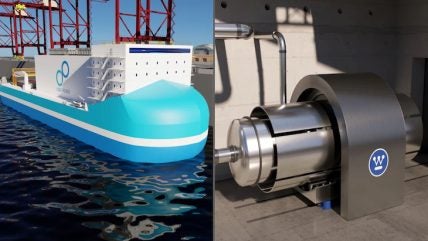
UK-based start-up Core Power and US-based Westinghouse Electric Company have formalised a cooperative agreement for the design and development of a floating NPP (FNPP) using Westinghouse’s eVinci microreactor design. In addition, the companies will collaborate to develop a regulatory approach to licensing FNPP systems.
The press release noted that FNPPs are “a game-changing approach to deploying nuclear energy to islands, ports, coastal communities and industry”. They “can be centrally manufactured and easily transported to operation sites, combining advanced nuclear technology with shipyard efficiency”. Westinghouse said the eVinci microreactor “is perfectly suited to FNPPs”.
Core Power CEO Mikal Bøe said there’s no net-zero without nuclear. Core Power was formed in 2018 “to create an organisation that would pave the way for development and successful deployment of advanced reactor technologies for the maritime industries”. Bøe told a press conference in June that the company is expecting to see its first orders for vessels equipped with nuclear reactors before 2030. This includes both FNPPs and nuclear-powered ships.
“Our unique partnership with Westinghouse is a game changer for how customers buy nuclear energy,” he says. Under the agreement, Westinghouse and Core Power will advance the design of a FNPP using the eVinci microreactor and its heat pipe technology which is expected to improve reliability while providing a simple, non-pressurised method of passively transferring heat. Heat pipes in the eVinci microreactor transfer heat from the nuclear core to a power conversion system, eliminating the need for water cooling and the associated recirculation systems.
The eVinci design is a transportable microreactor that will be fully factory built, fuelled and assembled, and capable of delivering combined heat (up to 13 MWt) and power (up to 5 MWe). Its small size allows for standard transportation methods and rapid, on-site deployment, with superior reliability and minimal maintenance. It will use TRISO (TRI-structural ISOtropic) nuclear fuel. It is one of several advanced reactor designs being supported by the US Department of Energy (DOE) Advanced Reactor Demonstration Program (ARDP) intended to accelerate the development and deployment of new reactor technologies.
In September, Westinghouse completed the front-end engineering & experiment design (FEEED) phase to test a eVinci prototype at Idaho National Laboratory (INL). The FEEED process is intended to support developers in design and planning for the fabrication, construction, and potential testing of fuelled reactor experiments at the DOME test bed being developed by DOE’s National Reactor Innovation Center (NRIC) at INL. The eVinci microreactor is one of three designs that could potentially start testing at DOME as early as 2026.
Bøe says: “A long series of identical turnkey power plants using multiple installations of the Westinghouse eVinci microreactor delivered by sea, creates a real opportunity to scale nuclear as the perfect solution to meet the rapidly growing demand for clean, flexible and reliable electricity delivered on time and on budget.”
Jon Ball, President of eVinci Technologies at Westinghouse says the agreement “will demonstrate the viability of the eVinci technology for innovative use cases where power is needed in remote locations or in areas with land limitations”. He added: “We look forward to our partnership with Core Power, bringing the unique advantages of eVinci microreactors to maritime and coastal applications, potentially even paving the way for future disaster relief efforts.”






